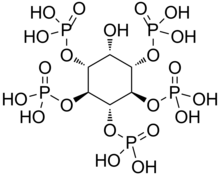| Revision as of 14:12, 9 August 2011 editCheMoBot (talk | contribs)Bots141,565 edits Updating {{chembox}} (no changed fields - added verified revid - updated 'DrugBank_Ref', 'UNII_Ref', 'ChEMBL_Ref', 'ChEBI_Ref', 'KEGG_Ref') per Chem/Drugbox validation (report [[Wikipedia_talk:Wi← Previous edit | Revision as of 19:17, 9 August 2011 edit undoStemonitis (talk | contribs)Extended confirmed users179,488 edits citation no longer in press: add page nos.; etc.Next edit → | ||
| Line 36: | Line 36: | ||
| }} | }} | ||
| '''Inositol pentakisphosphate''' (abbreviated '''IP5''') is a molecule derived from ] by adding a ] with the help of ] (IPMK). It is believed to be one of the many ]s in the ] family. It "is implicated in a wide array of biological and pathophysiological responses, including tumorigenesis, invasion and metastasis, therefore specific inhibitors of the kinase may prove useful in cancer therapy."<ref name= "IP Promotes apoptosis">{{cite journal | pmid=14755253 | year=2004 | last1=Piccolo | first1=E | last2=Vignati | first2=S | last3=Maffucci | first3=T | last4=Innominato | first4= |
'''Inositol pentakisphosphate''' (abbreviated '''IP5''') is a molecule derived from ] by adding a ] with the help of ] (IPMK). It is believed to be one of the many ]s in the ] family. It "is implicated in a wide array of biological and pathophysiological responses, including tumorigenesis, invasion and metastasis, therefore specific inhibitors of the kinase may prove useful in cancer therapy."<ref name= "IP Promotes apoptosis">{{cite journal | pmid=14755253 | year=2004 | last1=Piccolo | first1=E. | last2=Vignati | first2=S. | last3=Maffucci | first3=T. | last4=Innominato | first4=P. F. | last5=Riley | first5=A. M. | last6=Potter | first6=B. V. | last7=Pandolfi | first7=P. P. | last8=Broggini | first8=M. | last9=Iacobelli | first9=S. | title=Inositol pentakisphosphate promotes apoptosis through the PI 3-K/Akt pathway | volume=23 | issue=9 | pages=1754–1765 | doi=10.1038/sj.onc.1207296 | journal=]}}</ref> | ||
| IP5 also plays a role in defense signaling in plants. It potentiates the interaction of the plant hormone ] by its receptor |
IP5 also plays a role in defense signaling in plants. It potentiates the interaction of the plant hormone ] by its receptor.<ref>{{cite journal |last=Sheard |first=L. B. |year=2010 |title=Jasmonate perception by inositol-phosphate-potentiated COI1–JAZ co-receptor|journal=] |volume=468 |pages=400–405 |doi=10.1038/nature09430 |pmid=20927106 |pmc=2988090 |issue=7322}}</ref><ref>{{cite journal |last=Mosblech |first=A. |year=2010 |title=Jasmonic acid perception by COI1 involves inositol polyphosphates in ''Arabidopsis thaliana'' |journal=] | volume=65 |issue=6 |pages=949–957 |doi=10.1111/j.1365-313X.2011.04480.x |pmid=21205029}}</ref> | ||
| ==References== | ==References== | ||
Revision as of 19:17, 9 August 2011

| |
| Identifiers | |
|---|---|
| CAS Number | |
| 3D model (JSmol) | |
| ChEBI | |
| ChemSpider | |
InChI
| |
SMILES
| |
| Properties | |
| Chemical formula | C6H17O21P5 |
| Molar mass | 580.050 g·mol |
| Except where otherwise noted, data are given for materials in their standard state (at 25 °C , 100 kPa).
| |
Inositol pentakisphosphate (abbreviated IP5) is a molecule derived from inositol tetrakisphosphate by adding a phosphate group with the help of inositol polyphosphate multikinase (IPMK). It is believed to be one of the many second messengers in the inositol phosphate family. It "is implicated in a wide array of biological and pathophysiological responses, including tumorigenesis, invasion and metastasis, therefore specific inhibitors of the kinase may prove useful in cancer therapy."
IP5 also plays a role in defense signaling in plants. It potentiates the interaction of the plant hormone JA-Ile by its receptor.
References
- Sigma Aldrich
- Piccolo, E.; Vignati, S.; Maffucci, T.; Innominato, P. F.; Riley, A. M.; Potter, B. V.; Pandolfi, P. P.; Broggini, M.; Iacobelli, S. (2004). "Inositol pentakisphosphate promotes apoptosis through the PI 3-K/Akt pathway". Oncogene. 23 (9): 1754–1765. doi:10.1038/sj.onc.1207296. PMID 14755253.
- Sheard, L. B. (2010). "Jasmonate perception by inositol-phosphate-potentiated COI1–JAZ co-receptor". Nature. 468 (7322): 400–405. doi:10.1038/nature09430. PMC 2988090. PMID 20927106.
- Mosblech, A. (2010). "Jasmonic acid perception by COI1 involves inositol polyphosphates in Arabidopsis thaliana". The Plant Journal. 65 (6): 949–957. doi:10.1111/j.1365-313X.2011.04480.x. PMID 21205029.
This biochemistry article is a stub. You can help Misplaced Pages by expanding it. |